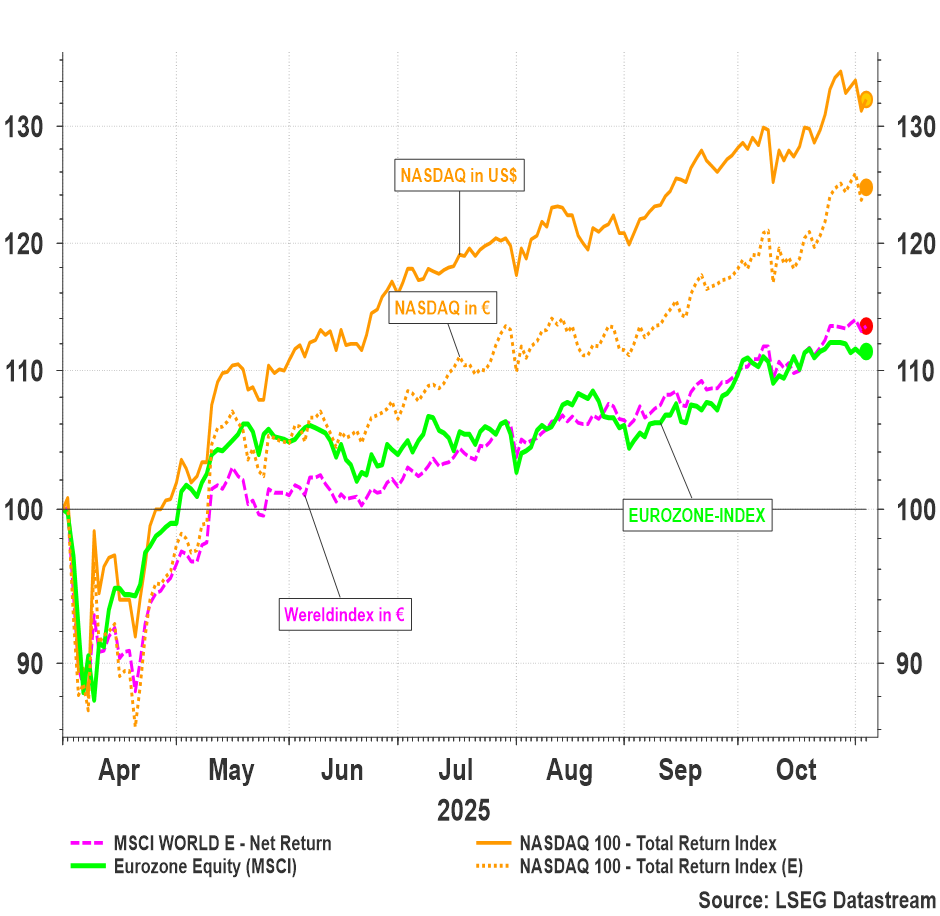November 27, 2025
OneLife offers Belgian life insurance intermediaries an annual certified training programme covering various topics: financial aspects presented by renowned fund managers, legal clarification provided by a Belgian life insurance expert and macroeconomic analysis.
In early November we invited Stefan Duchateau, PTAM Portfolio Manager and Professor of Portfolio Management & Risk Management at KUL and UHasselt, to present a digital masterclass on the current financial environment. Stefan Duchateau has provided the following supplement to his market analysis, with his article entitled “October: review of a turbulent month”.
October: review of a turbulent month – AI determines the direction of the stock market
According to Mark Twain, October is a particularly dangerous month for speculating in stocks. “The others are July, January, September, April, November, May, March, June, December, August and February” he added, not without a little sarcasm from an 1894 novel.
Despite the warning, October continued the upward trend. The S&P 500, NDXT and EU50 all set new records.
The wave of AI investment remains the main driver of stock market growth expectations. Despite the geopolitical turmoil, such investments are driving the markets in fits and starts. The scenario: an earnings increase of over 75% by US technology companies over the next 3 years. This leap is principally anticipated to be driven by expected productivity gains due to AI applications.
The scenario translates into historically high price-to-earnings ratios and stratospheric prices for companies directly or indirectly linked to AI. Given current earnings, S&P 500 stocks are trading at multiples well above their long-term average.
This is an indication of either extreme overvaluation or exceptional growth prospects. At times, one interpretation will take precedence over the other. This results in waves of equity market volatility.
But if the positive outlook is confirmed, it will be said that companies were underpriced at this stage. In the meantime, where any doubts exist, significant intermediate corrections seem inevitable. That is precisely what we have seen in recent days. It does not necessarily take a direct trigger for markets to fall, with the highest priced stocks leading the way. After a long period of heated trading, investor confidence is liable to go up in flames. All it takes is a spark for ratings to turn from green to bright red.
Accordingly, and despite excellent results, shares of companies such as Palantir have fallen. Previously, the mega-group Meta Platforms[i] (formerly Facebook) had suffered the same fate. Reactions to these results, including at Microsoft, show that strong revenue growth and heavy investment in AI are no longer enough. No, these groups now need to show tangible results from the huge investments they have made in recent years in order to build AI capabilities. Apple, and above all Alphabet and Amazon, already seem to be one step ahead in this process. They have recently been rewarded by the markets.

Chart 1: Price developments after “Liberation Day” (02.04.2025)
To put these setbacks in perspective: while the Nasdaq has lost a few percent in recent days, it has still gained more than 30 percent since the beginning of April this year. This is despite the heavy losses that followed the somewhat performative “Freedom Day” announcements in the White House Rose Garden.
Investors are fully aware of the dangers posed by sharp corrections. Yet the lure of the sirens loudly extolling the opportunities of the new industrial revolution remains irresistible. Tech companies’ earnings growth serves as a stabilising influence in the event of stock market turbulence. The market therefore quickly wiped out every downturn.
Published results significantly exceeded the already very high expectations during the past quarter. The vast majority of US companies have already reported their Q3 2025 performance. In more than 80% of cases, earnings outperformed the initially expected double-digit growth, by 8% on average.
The biggest surprises came from Finance and Tech, far beyond their expectations. Utilities and Consumer Goods also contributed substantially to overall quarterly growth.
The contrast with Europe is striking. Here, only a slight majority of companies posted earnings above expected growth of 4.3%. This increase was mainly due to gains in Banking.
Geopolitics and inflation
Positive geopolitical news emerged last month. The US-China trade dispute appears to be easing, at least temporarily, after the Chinese leader indicated that he would relax his stranglehold over crucial US technologies.
This means postponing the most restrictive measures on exports of rare earths by 1 year (?). However, the threat of future shortages has not disappeared. Above all, it shows how easily the United States can be put under pressure when China wields its sword.
The sharp fall in the stock prices of rare earth mines outside China’s control, following the temporary suspension of the export ban, therefore seems somewhat precipitate. Their strategic importance is major and should, in the long term, revive the interest of long-term investors.
In terms of inflation, the US CPI indices also provided good news. They were published very late due to the US government shutdown. Inflation has been rising, but price increases have not been as strong as feared.
The initial concern was the anticipated impact of the tariff increases. About half of these are passed on to US consumers. However, the prices of locally-produced goods, and especially services, have fallen. This offsets the higher prices of imported goods to a surprisingly large extent. Better yet: once the one-off effect of import prices has passed through the system, inflation expectations point to a continued and gradual fall in consumer inflation.

Chart 2: Expected development of US inflation over the coming years
These figures have given the chair of the Fed sufficient room for manoeuvre to cut key rates again. According to our latest calculations, the downside potential is limited to two additional rounds of 0.25% each, expected in January and July 2026.

Chart 3: Expected change in the US key rate
The ECB, for its part, clings to dogmatic views dating back to the early 1960s, despite their already being counterproductive at that time. As a result, the European key rate is unfortunately still frozen at its current level. What could, in this context, lead to a welcome “thaw”? A further fall in European inflation (as expected) or a more inspired management team. Preferably one with greater discernment and courage, and a solid background in economics.
[i] Excluding a substantial exceptional tax
